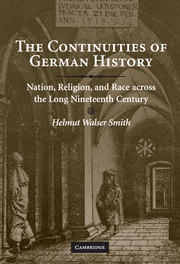Book contents
- Frontmatter
- Contents
- Introduction
- 1 The Vanishing Point of German History
- 2 The Mirror Turn Lamp: Senses of the Nation before Nationalism
- 3 On Catastrophic Religious Violence and National Belonging: The Thirty Years War and the Massacre of Jews in Social Memory
- 4 From Play to Act: Anti-Jewish Violence in German and European History during the Long Nineteenth Century
- 5 Eliminationist Racism
- Conclusion: Continuities in German History
- Acknowledgments
- Index
2 - The Mirror Turn Lamp: Senses of the Nation before Nationalism
Published online by Cambridge University Press: 05 June 2012
- Frontmatter
- Contents
- Introduction
- 1 The Vanishing Point of German History
- 2 The Mirror Turn Lamp: Senses of the Nation before Nationalism
- 3 On Catastrophic Religious Violence and National Belonging: The Thirty Years War and the Massacre of Jews in Social Memory
- 4 From Play to Act: Anti-Jewish Violence in German and European History during the Long Nineteenth Century
- 5 Eliminationist Racism
- Conclusion: Continuities in German History
- Acknowledgments
- Index
Summary
“It must go further still, that soul must become its own betrayer; its own deliverer, the one activity, the mirror turn lamp.”
W. B. YeatsIn a little-known pamphlet entitled “Explanation of the New Instruments of the Sun,” published in 1528, the mapmaker and cosmographer Sebastian Münster attempted to enlist his fellow countrymen in a collaborative effort that would reveal the “hidden beauties” of “our common German fatherland” and create a work “in which one will see all of Germany … as if in a mirror.” The mirror would reflect “Germany's territories, cities, towns, villages, distinguished castles and monasteries, its mountains, forests, rivers, lakes, and its products, as well as the characteristics and customs of the people, the noteworthy events that have happened, and the antiquities which are still found in many places.” But as one man alone could not “describe Germany properly,” it would be necessary to collaborate. For Münster, “properly” meant by observation and measurement, and to aid his collaborators, the leading humanists of the day, Münster sketched a regional map of the area around Heidelberg, where he then taught. Modest in appearance, the map was the first to use sighting lines to form triangles, from which Münster could measure angles to the towns he depicted and then estimate the distances to them. A primitive form of triangulation, Münster's method represented a small but significant step forward in geographical accuracy.
- Type
- Chapter
- Information
- The Continuities of German HistoryNation, Religion, and Race across the Long Nineteenth Century, pp. 39 - 73Publisher: Cambridge University PressPrint publication year: 2008

